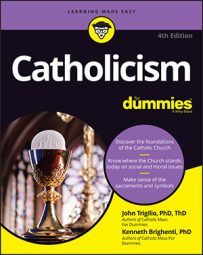The rise of the Holy Roman Empire
On Christmas Day a.d. 800, Pope Leo crowned Charlemagne (King of the Franks) the Holy Roman Emperor. Pope Leo's intent was that one ruler, the Holy Roman Emperor, would be the secular ruler over the known world. But by having the emperor crowned by the pope in Rome, the Church achieved the superiority it needed: The one who installed could also depose. So later, in the 11th century, when the Holy Roman Emperor Henry IV tried to control who was made bishop in his realm, he was deposed and excommunicated by Pope Gregory VII, also known as Hildebrand.Under Charlemagne, one standard liturgical language also united the people of the Holy Roman Empire. Latin was the lingua franca (common language) for the Catholic Church and the government as well. This made sense because the other languages spoken at the time were still primitive (they didn't have an extensive vocabulary), and many of them were never written — only spoken. Making Latin the language of worship solidified the empire because people could travel anywhere and still experience the same exact Mass.
Splitsville: The East/West schism
The Eastern Roman Empire, known as Byzantium, didn't take too kindly to having a Holy Roman Emperor or empire arise because it was clear that the pope wanted to make the Carolingians (the dynasty that included Charlemagne) the sole rulers of the entire old Roman Empire — East and West. This would make the emperor of Byzantium and the Patriarch of Constantinople, who was always closely aligned with him, virtually redundant. Ever since the old Roman Empire was divided in a.d. 286 and the imperial town of Constantinople was established by the Emperor Constantine (a.d. 306–337), the Eastern part of the Roman Empire survived despite the barbarian invasions in the West. After Rome fell in a.d. 476, Byzantium was the only vestige of the Empire.The Byzantines saw the crowning of Charlemagne as Holy Roman Emperor as a slap to the Eastern emperor and the empire itself. From then on, relations between the East and the West deteriorated until a formal split occurred in 1054, called the schism. The Eastern Church became the Greek Orthodox Church by severing all ties with Rome and the Roman Catholic Church. In the end, Pope Leo and the Patriarch of Constantinople excommunicated each other and their churches. (In 1965, Pope Paul VI and Patriarch Athenagoras I of Constantinople removed the mutual excommunications.)
The Crusades
The intention of the Crusades was initially honorable: It was a response to a plea for help from the Byzantine Empire, still a sister church at the time. In 1095, the Byzantine Emperor, Alexius Comnenus, sent ambassadors to Pope Urban II in Rome, asking for help to defend Christianity from an imminent attack. The Saracens (Arab Muslims during the time of the Crusades) had overrun the Holy Land, and Christians were no longer free to move about and visit their holy pilgrimage sites. A crusade to free the Holy Land was under way before you knew it.The pope also saw the Crusades as a way to diffuse and dissolve internal fighting and battles being waged by the Christian monarchs for territory and power. (Clear and defined nation states didn't exist as of yet.) He wanted to unite them under one banner, Christianity, for one purpose, to free the Holy Land for pilgrims, against one common enemy, Islamic extremism and expansionism.
Between 1095 and 1270, eight Crusades took place. In addition, the infamous Children's Crusade occurred in 1212: On their own, thousands of children wanted to free the Holy Land, but ruthless and evil men took advantage of them and sold many into slavery to some Moors (Muslims that inhabited Spain). Many of the children died of hunger and exhaustion on the way.Deemed a total failure, the Crusades didn't free the Holy Land from Islamic rule, and injustice, debauchery, greed, envy, animosity, petty infighting, and prejudice erupted on both sides during these holy wars. For example, Latin Christians were invited by their Eastern brethren to free the Holy Land, and yet Crusaders attacked Byzantine territory, seizing it for themselves. Christian kings and princes often fought on the way to a crusade; jealousy and envy prevented them from working together successfully. In addition, brutality and the absence of mercy — or even human decency — crossed over religious boundaries. Christians and Muslims alike slaughtered helpless, innocent women and children. Both sides acted atrociously. It wasn't that the religions of Christianity and Islam were at war; rather, some members of those religions abused faith as a catalyst for territorial, economic, and political purposes on both sides.
That said, had the Crusades not occurred, many historians believe that the Islamic military forces would've taken the opportunity to prepare for a massive assault on Europe, and no unified leadership or defense would have prevented it. The Crusades did contain the expansion. They also reopened trade routes to the Far East, which had been closed for several centuries due to the strength and spread of Islam in Arabia and the Middle East.
To Catholics, the Crusades are a poignant reminder that the ends never justify the means. The Catholic belief is that no matter how lofty the goal or noble the purpose, only moral means can be used.

